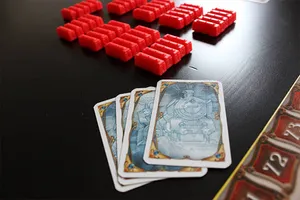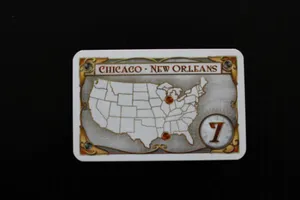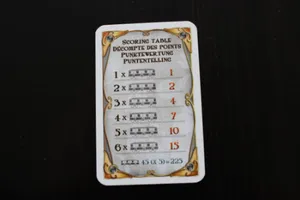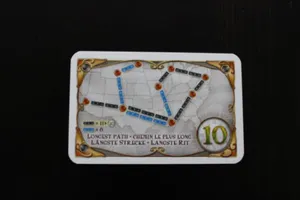Board Game Review: Ticket To Ride
May 10, 2014

Ticket To Ride is the first board game in my collection that's from a different distributor. That doesn't mean less fun of course.
At first I used to play Ticket To Ride on my Iphone. After playing it for a while, I really wanted to try the board game. I bought it after a few months and I can tell you that it is a fun and easy to learn game with very few rules.
So let's start with Ticket To Ride
In ticket to ride the goal is to connect the stations on your tickets and get as much points out if as you can. It's a game that can be played with 2 to 5 players. So that's already nice isn't it? I love games that are playable with 2 or more players. Since I do not always have a third player hanging around.
Inventory:
- 5 different colours of train wagons 45 per colour.
- 30 Destination ticket cards
- train car cards in 9 different colours
- big board with a map of North America
- A longest route bonus card
- 5 wooden scoreboard markers

Preparations before playing:
Every player chooses a color and gets all the train wagons from that certain colour.

Every player also gets three destination tickets to start with and four train car cards. The remaining cards have to be put on the table, facedown. From the stack of remaining train car cards you take the first five cards and put them facing upwards on the table.


Time for some rules:
There are three possible actions you can take:
- Draw new train car cards
- Claim a route.
- Get more destination tickets
This means that you can take one action per turn. No more, no less.
The actions explained in detail:
Take new train car cards:
You must take two train car cards from either the five cards that are lying open on the table and/or from the stack of train car cards that is placed facedown.

But when you choose to take a locomotive (rainbow card) from the open cards, you are limited to take only just that one card. (So no second train car card from either group of cards)
If you first grab a card from a different color and there's a locomotive on the open cards, you also aren't allowed to take that one. You can however take a second card from either the other coloured cards that are lying face-up. Or you can take the top card of the stack.


Another scenario is when for example you take the top card from the facedown stack and it's a locomotive. This card still counts as one card, so you are allowed to take a second train car card from either the open cards or the stack. Just not a locomotive from the open cards. Any other color is fine.
After every train car card that is drawn from the open cards, you directly place the top train car card from the facedown stack on the empty spot.
Just to be clear: When you draw your first card from the open cards, you immediately replace the empty spot with one from the stack. And then you can take your second card if you haven't drawn a locomotive of course.
Claim a route:
A route is the track that connects two cities. You have two kinds of tracks, the grey tracks and the coloured one.
Grey tracks can be payed with any color you like. But you have to choose one color to pay with and it has to be exact the same amount as the spaces.
One of the exceptions is that you can use the locomotives as a replacement if you don't have enough cards from that certain color to pay with. One locomotive only replaces one other coloured card.

A route can only be claimed by one player. But there is one exception. On the board you will notice that some cities are connected by a double route. This can only be used when playing the game from four to five players. And it means that one other player can claim that route. The first player has the luxury of choosing between the two colours the route is displayed in.
The second one just has to pay in the colour that's leftover.

Draw destination tickets:
When you choose to take this action, you must draw three destination tickets from the deck.
You can choose how many you keep, but you must keep at least one.
Keep in mind that unfinished destination tickets will result in a subtraction of points at the end of the game.
A destination ticket always mentions two cities that you have to connect to each other, a map of where those cities are located. And in the right corner at the bottom the shortest possible route, which also counts as points when finished.

Earning points:
In Ticket To Ride you earn points by claiming routes. In the following picture you will see how much points each route length is worth.

And at the end of the game the finished destination ticket points will be added as well to your score. The destination ticket in this picture is worth seven points when it's finished.


But there's also the longest route card. This adds ten bonuspoints to your score.


Conclusion:
The reason I like this game is simply because it doesn't have many rules and this version is playable from two to five players.
And like many other board games, Ticket To Ride also has expansions and variations.
I mentioned it before, that there are also digital versions available.
You can find it:
- on the web
- on steam for Mac, Linux and Windows
- on mobile for Android and iOS
You can find more about it here.
So choose your medium and start playing!



